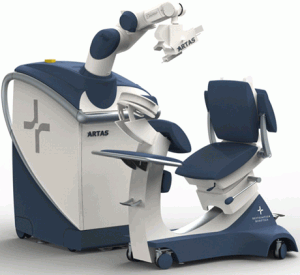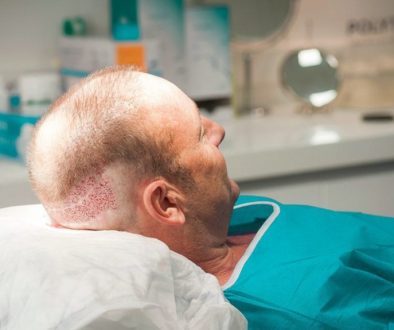Dr. Harris Answers Critical Questions About the ARTAS Hair Restoration System for Automating Follicular Unit Extraction (FUE)
 Recently, follicular unit extraction (FUE) expert and recommended hair transplant surgeon Dr. Jim Harris recently became the first physician to purchase the ARTAS Hair Restoration System. To read more about Dr. Harris’ acquisition of this potentially revolutionary device, visit “Dr. Jim Harris Purchases the First ARTAS Hair Restoration System for Automating the Follicular Unit Extraction (FUE) Hair Transplant Procedure“.
Recently, follicular unit extraction (FUE) expert and recommended hair transplant surgeon Dr. Jim Harris recently became the first physician to purchase the ARTAS Hair Restoration System. To read more about Dr. Harris’ acquisition of this potentially revolutionary device, visit “Dr. Jim Harris Purchases the First ARTAS Hair Restoration System for Automating the Follicular Unit Extraction (FUE) Hair Transplant Procedure“.
Dr. Harris’ recent acquisition of the ARTAS Hair Restoration System provided the opportunity to ask a proven FUE specialist and expert surgeon crucial questions about the this robotic FUE machine. Below, view Dr. Harris’ expert answers regarding the ARTAS and automating at least a portion of the hair transplant procedure.
(Q) 1. What is your philosophy on automating the hair transplant procedure using devices such as the ARTAS Hair Restoration System?
(A) The answer really relates to what the impact will be on patient results. Powered FUE devices, when used in the right hands, offer greater speed and hopefully better grafts, but not always. For example, there is a supposed “automated” device on the market right now, but in reality it is nothing more than a sharp rotational punch coupled with a suction powered graft extractor.
Every possible difficulty in using a sharp dissection device still exists with this product because a technician or surgeon is making guesses about the follicle angle/direction and trying to manually make the punch go in the direction and depth that the operator is guessing it should go. All these individual guesses and decisions make for a very unforgiving system. I believe the Powered SAFE Scribe System for FUE that I developed is more forgiving than a sharp punch system, but it is still subject to the skill of the operator.
The only real “automated” device in existence is the ARTAS System. The precise measurement of hair angles and directions by the vision and camera system and the computer algorithms to assess numbers of hairs and interfollicular distances takes the “guesswork” out of the FUE process. In essence, the graft dissection process is not reliant upon the surgical skills of the operator and his or her judgment.
I believe that an automated device, such as the ARTAS System, that will produce high quality grafts on a consistent basis, regardless of the operator, is a very useful tool for the benefit of patients.
(Q) 2. What made you purchase the ARTAS machine given its hefty price tag?
(A) There are multiple reasons for the purchase. The first is that the ARTAS FUE device gives patients another treatment option with excellent clinical results. Now I can leverage my office resources, staff and operating rooms, more efficiently so I can offer patients FUE surgery at a lower cost. Finally, this system is cutting edge technology and enhancements like this will benefit my patient’s outcomes.
(Q) 3. What are your plans for implementing the ARTAS Hair Restoration System into your practice?
(A) The implementation of the ARTAS System into my practice began last week. The system was installed in a couple of days and preliminary testing has begun and will be completed this week. Immediately following we will begin treating patients with robotic assisted FUE surgery. We will start with cases of 1000-1500 grafts and ramp up from there. We will eventually be able to have robotic surgery every day and this will ease up on the waiting time to have hair transplant surgery in my practice. I will still continue to offer follicular unit transplantation (FUT) as well as Power SAFE System FUE, as there is still a role for these procedures.
(Q) 4. What impact will the ARTAS Hair Restoration System have on the future of your practice and in your opinion, the future of follicular unit extraction (FUE)?
(A) Potential hair loss sufferers have seen FUE rise to the forefront as a viable harvesting option, unfortunately it has not been embraced by hair restoration physicians to the same degree. Some of the reasons for the slow adoption are the time and effort required to become proficient and the inconsistency of the follicular unit graft quality in the neophyte’s hands. ARTAS addresses both of these barriers very effectively. I think that eventually most practitioners will have to offer FUE or be perceived as not practicing the “state of the art” hair restoration.
The exciting aspect of the ARTAS System is that the current device is the first step towards multiple aspects of robotic assistance in the field of hair restoration. As principal investigator, I have had the privilege to work with a cadre of very smart individuals with extensive engineering and robotic experience and we see the expanding potential of this system. The team’s commitment to improving the current protocols and adding additional capabilities will produce a system that will enhance the entire hair transplant patient experience – from the actual surgery to the final clinical results. There are current discussions and plans for robot assistance in implant site creation, graft extraction technologies and graft implantation. Some of these investigational and developmental activities have already begun.
The exciting aspect of having this system and providing FUE is that there is great upward potential for my practice and for patients. The delivery of FUE and the patient’s experience will constantly improve and the entire procedure and hair restoration delivery model will evolve … which is the key to progress.
(Q) 5. I assume therefore, the ARTAS Hair Restoration System can adjust and adapt to various depths and widths and extract follicular units of varying sizes with minimal skill required by the physician? That said, I would assume that the incision making and placement process also critical to producing excellent results continues to require the skill of an experienced surgeon?
Your first characterization is correct…the robot determines these variables and makes the appropriate adjustments. As you state, until the robot with these capabilities has been developed the final result will still require the hair restoration physician’s and staff’s skills inherent to hair restoration.
(Q) 6. Do you and/or Restoration Robotics advocate that brand new “neophyte” surgeons and inexperienced staff with only minimal training can produce FUE results on par with experienced surgeons with the ARTAS Hair Restoration System? I’ve always believed that the skill and experience of the surgeon is paramount to any tool/device they use.
You are absolutely correct about the fact that the success of the procedure depends on the experience and skill of the surgeon. When I said “neophytes” could produce excellent results I was referring to neophytes to FUE. It is neither my suggestion nor the plan of Restoration Robotics (as I understand their marketing focus) to place the device in the hands of non hair restoration physicians. As a matter of fact their efforts have been towards the leaders in the field of hair restoration…a veritable list of Who’s Who in this field.
Because Dr. Harris just recently acquired the ARTAS device, we look forward to observing the results of the automated FUE procedure and how his opinion of the machine changes over time. In the past, some automated FUE devices (such as the NeoGraft Hair Transplant Machine) have been marketed to inexperienced hair transplant surgeons with little to no training. However, we maintain the opinion that this practice is not advantageous to patients. In the end, the outcome of an FUE procedure depends on the skill and talent of the operating hair transplant surgeon which can be assistanced and/or enhanced by the tool he/she uses.
Because Dr. Harris is a talented, trained and ethical hair transplant surgeon and FUE practioner, it will be interesting to watch carefully to see ifthe ARTAS Hair Restoration System can produce healthy and viable grafts in experienced hands and whether or not the ARTAS will revolutionize the practice of follicular unit extraction.
A special thanks to Dr. Harris for taking the time to provide his expert opinion and educate the online patient community.
_____________________________
Bill and Blake (Future_HT_Doc) – Managinng Publisher and Editorial Assistant for the Hair Transplant Network, the Hair Loss Learning Center, the Hair Loss Q&A Blog, and the Hair Restoration Forum
Follow our community on Twitter
Watch hair transplant videos on YouTube
Get Proven Hair Loss Treatments at the Best Prices by visiting our new Online Hair Loss Product Store
Technorati Tags: follicular unit extraction, FUE, hair transplant surgeon, ARTAS Hair Restoration System, hair transplant, Powered SAFE Scribe System, ARTAS FUE, FUE surgery, robotic assisted FUE surgery, hair transplant surgery, follicular unit transplantation, FUT, Power SAFE System FUE, hair loss, hair restoration physicians, follicular unit graft, ARTAS, hair restoration, hair transplant patient, NeoGraft Hair Transplant Machine



